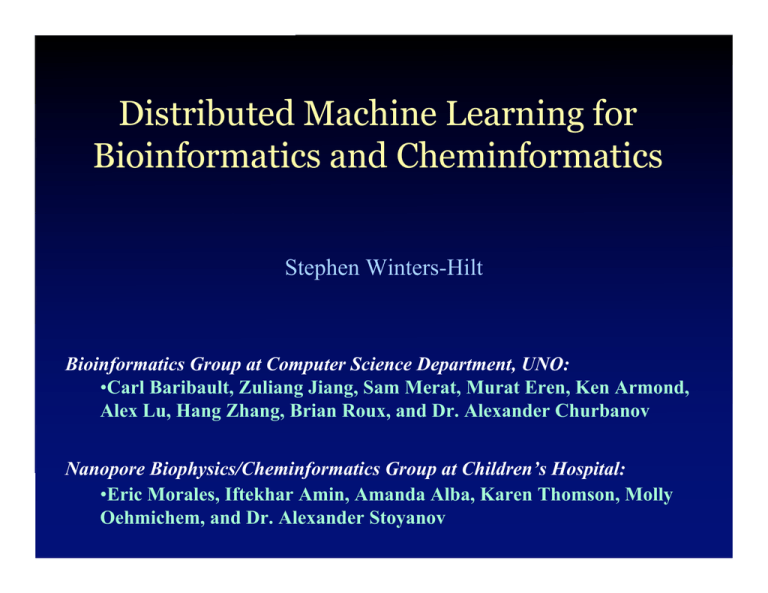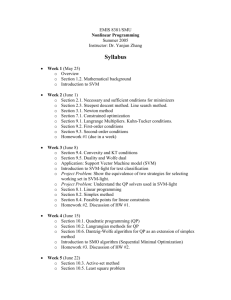Distributed Machine Learning for Bioinformatics and Cheminformatics Stephen Winters-Hilt
advertisement

Distributed Machine Learning for
Bioinformatics and Cheminformatics
Stephen Winters-Hilt
Bioinformatics Group at Computer Science Department, UNO:
•Carl Baribault, Zuliang Jiang, Sam Merat, Murat Eren, Ken Armond,
Alex Lu, Hang Zhang, Brian Roux, and Dr. Alexander Churbanov
Nanopore Biophysics/Cheminformatics Group at Children’s Hospital:
•Eric Morales, Iftekhar Amin, Amanda Alba, Karen Thomson, Molly
Oehmichem, and Dr. Alexander Stoyanov
Distributed Data Sharing
Data Warehousing: (1-10 TB long-term)
Channel Current (and other power signal) Data Repository (~ 1TB)
Genome Repository (prokaryotic and eukaryotic) (~ 10TB)
Data Mining: (additional 1-10 TB short-term)
High Order sub-sequence interpolated Markov Model Construction
Distributed Hidden Markov Model Processing
Distributed SVM Chunk Processing
Application Areas:
Cheminformatics -- enables Nanopore Detector capabilities
Bioinformatics -- used for gene-structure identification (including
regulatory regions) and comparative genomics
The α-Hemolysin Nanopore Detector
α-Hemolysin with a
9bp DNA hairpin
Nanopore Conception:
J.J. Kasianowicz; S. Bezrukov, A.
Parsegian; I. Vodyanoy; D. Branton;
D. Deamer; M. Akeson; H. Bailey; …
Hagan Bailey, Sci. Am.
α-Hemolysin self-assembles
from solution soluble monomers
The Streptavidin and Biotin Interaction: Ka~1014M-1
Tetrameric Streptavidin:
Streptavidin: 53,000 Daltons
Near Neutral pI
Hydrogen Bonding with Biotin:
Biotin: 244.31 Daltons
S. Freitag, I. Le Trong, L. Klumb, P.S. Stayton, R.E. Stenkamp; Structural Studies of the Streptavidin
Binding Loop; Protein Science 6 (1997), 1157 - 1166.
Tetrameric Streptavidin binding to a Biotinylated DNA
Hairpin (9gc-Biot) Captured in the Nanopore Detector:
Biotinylated DNA Hairpin
Streptavidin Binding
Streptavidin Binding
Biotinylated DNA Hairpin
8.00E-02
7.00E-02
6.00E-02
5.00E-02
4.00E-02
3.00E-02
2.00E-02
1.00E-02
0.00E+00
0.1
0.09
0.08
0.07
0.06
0.05
0.04
0.03
0.02
0.01
0
0
20
40
60
80
100
120
140
0
50
100
Modified DNA Hairpin
Our DNA hairpin has eight base pair
stem region terminating in GC and a
four Thymine loop. An internal DNA
modification is added at the 10th base
using a modified Thymine with a six
carbon linker.
Thymine linker
Biotin
Bt-DNAhp Signal Suppression with Streptavidin Binding
The left column is a series of channel's current reading (each three minute in
length) displaying capture events of BiodT-DNA HP. On the right we show a
decrease of these capture events as a result of an increase in Streptavidin
concentration. Note the change in signal itself. Molar ratio of Streptavidin to
hairpin to 2:1.
Negative-Specificity Control: Mixtures of
“-DNAhp” molecules and Streptavidin
The left column is a series of observations from a negative-specificity control experiment
involving “-DNHhp” before addition of Strepatvidin, the right column after addition of
streptavidin. Each signal trace is the signal observed during a 3-minute interval. “-DNHhp”
has the same structure of our biotinylated 8GC hairpin only without the biotin (just the six
carbon linker). Upon addition of Streptavidin no difference in capture rates or change in
toggle signal were observed (at equal streptavidin concentrations as used in previous
experiments).
SVM Projection Score Histogram
Score
Cluster identification and counting via a SVM projection-score histogram. (This
corresponds to SVM-External Clustering in Decision Space). Biotinylated hairpin signals
comprise the positives. appearing as the large peak scoring around 1.0. The mixture
signals seen after introduction of streptavidin are shown as the light blue bars. The scoreclustering at 0.5 in the
projection-score
histogram corresponds to (unbound)
biotinylated DNA hairpin signals that are successfully projected towards their
corresponding signals in the positives. The other, clear, negative signals (in light blue),
that score around –1.0, are hypothesized to correspond to the streptavidin-bound
biotinylated DNA hairpins.
GC4-DNA Y-shaped Aptamer
Our bifunctional Y-shaped aptamer with 5’-CGGC-3’ overhang (left), hairpin with
complementary overhang (right) and in the middle complement base pair annealing to form
composite molecule (center). The base of the Y shape in the event-transduction terminus
that inserts into the alpha hemolysin channel to produce the blockade signal.
Nanopore Cheminformatics & Control Architecture
LabWindows Server now used. Data sent to cluster of Linux Clients via TCP/IP channel. Linux clients run
expensive HMM analysis as distributed processes (similarly for off-line SVM training). The sample classification
is used by the Server to provide feedback to the nanopore apparatus to increase the effective sampling time on the
molecules of interest (this can boost nanopore detector productivity by magnitudes).
Real-time Channel Current Cheminformatics
DAQ
Nanopore
Apparatus
Amplifier
LabWindows Software
15.000
sample data
points from
the
blockade
signal
Network
Feedback
information:
whether reject or
Keep the
molecule
(Records signals, visualizes signals, uses feedback server to control the experiment)
Feedback Server
(Runs HMM and SVM on data. Response time is less than 1 second for 15.000 samples)
ABF
File
HMM
SVM
Feature
Vector
SVM Model Learning
Labwindows/Feedback Server Architecture with Distributed CCC processing. A capture signal generated with the nanopore
apparatus is filtered and amplified before it is sent through the DAQ. The Data AcQuisition device converts the analog signal to
digital format for use in the display and recording of data in binary Axon (Molecular Devices) format. In the pattern recognition
feedback loop, the first 200 ms detected after drop from baseline are sent via TCP-IP protocol to the HMM software, which
generates a profile for each signal sent. The HMM-generated profile is processed with the SVM classifier to compare the realtime signal with previous training data in order to determine whether the signal is acceptable. The HMM learning (on-line) and
SVM learning (off-line), denoted in orange, are network distributed processes for N-fold speed-up, where N is the number of
computational threads in your cluster network.
HMM/EM EVA (Emission Variance Amplification) Projection
for simplified tFSA Kinetic Feature Extraction:
Source: 1.0 σ
1.1 σ
1.5 σ
2.0 σ
4.0 σ
1.0 sec
Kinetic feature enhancement via a novel HMM/EM filter that “projects” via a
gaussian parameterization on emissions with variance boosted by the factor indicated.
HMM with Duration
The HMM-with-duration (HMMwD) is an HMM that directly
models the “true” sub-blockade duration probabilities, and provides
a strong link to the underlying kinetic (physical) information that is
desired (an EM optimization can be directly performed to yield the
best estimate of the probability distributions on state durations. The
means of those distributions, the kinetic half-lives, directly relate to
the underlying kinetic coefficients). HMMwD is parameterized by
the internal HMM signal representation (the emission and transition
probabilities, and the duration distributions on state lifetimes), and
can be efficiently implemented. With HMM-with-duration, feature
extraction is more robust on long-lifetime states.
Novel, exact, HMMwD for EM and Viterbi
Standard HMM:
p(d = x) = (aii x-1) (1-aii).
Restricted to the geometric distribution.
New HMMwD:
p(d = x) = (∏i=1..x-1 p(d ≥ i+1)/p(d ≥ i)) (1-p(d ≥ x+1)/p(d ≥ x)).
This formula’s advantage is the calculation of p(d) can be
distributed among the x consecutive steps, and it provides the
exact distribution.
New HMM Table construction uses carry-sum cells for each state,
with the new HMMwD p(d = x) definition. Computational time
increases by a factor of D/N +1, where N=number of HMM states,
D=number of bins in the length distribution representation, 1000
is used. If the number of states > 1000, then the factor is approx.
1! This provides a 1,000,000 speedup factor over conventional
HMM-with-duration.
Footprint State & Transition Enumeration
– Atomic states involving exon, ex, and intron, ix, are context-specific (frame,
direction), but not junk, j.
– Use ê, î in order to denote reverse encodings.
– * Support the 3 stop codons {TAA, TAG, TGA} explicitly.
– The result is 33 allowed transition states …
• 13 XX-types: ixix(3), îxîx(3), exey(3), êxêy(3), jj(1)
• 20 eij-types: exix(3), êxîx(3), ixex(3), îxêy(3), e2j(3*), ê2j(3*), je0(1),
jê0(1)
– Impose minimum length duration on states
– For each eij-dimer generate F-1 footprint states.
– The result is (13+20*(F-1)) allowed footprint states
• 13 XX-types: ixix->ixix(3), îxîx->îxîx(3), exey->ey ez (3), êxêy->êyêz(3), jj> jj(1)
• 20*(F-1) eij-types: exix(3*(F-1)), êxîx(3*(F-1)), ixex(3*(F-1)), îxêy(3*(F1)), e2j(3*(F-1)), ê2j(3 *(F-1)), je0(1*(F-1)), jê0(1*(F-1))
• Have approx. 20*F states, with typical F=50 footprint sizes will expect
to have approx. 1000-state HMM processing via this approach.
Preliminary Results
•
Chromosome I; C. Elegans; R=0, L=2, r=l=3 (or F=6)
– Individual exon bases
• sn= 0.88 (matching e base count/ annotated e base count)
• sp= 0.86 (matching e base count / predicted e base count)
– Full exon
• SN= 0.62 (full exon match count / annotated exon count)
• SP= 0.55 (full exon match count / predicted exon count)
– Best Overall:
6-6-6-0-vfull_m2_viterbi with 0.70
– Best je detection: 6-7-6-0-vfull_m2_viterbi with 1.0
– Best ej detection: 5-5-6-0-vfull_m2_viterbi with 0.78
– Best ie detection: 1-5-6-0-vfull_m2_viterbi with 0.8125
– Best ei detection: 2-1-10-0-vfull_m2_viterbi with 0.74
Distributed HMM/EM processing
Dynamic Programming Table
Partitioned Dynamic Programming Table
Using Markov short-term memory
property, recover exact Viterbi traceback
at this point
Post EM-relaxation of join statistics (recover emission and transition probabilities:
Computational time reduced by ~ N on cluster with N nodes.
Markov Model --> SVM Feature Vector
Markov Model (MM) Profile (V. cholerae):
Index: ∞ .…. -17 ….... -2 -1 | 0
------------(A/G)-----------------|( A
A
0.25……..0.4…………..0.4 |.93
C
0.25……..0.1…………..0.3 |.01
G
0.25……..0.1…………..0.2 |.60
T
0.25……..0.4…………..0.1 |.09
1
T
0
0
0
1
2 3 …… ∞
G)---------------0 0.4……..0.25
0 0.3……..0.25
1 0.2……..0.25
0 0.1……..0.25
Log odds ratio: log[Pstart(sub-sequence)/Pnon-start(sub-sequence)] > 0 --> a start region
Classifier based on log[Pstart/Pnon-start] = Σi log[Pstart(xi=bi)/Pnon-start(xi=bi)].
Rather than a classification built on the sum of the independent log odds ratios, the
sum of components could be replaced with a vectorization of components:
Σi log[Pstart(xi=bi)/Pnon-start(xi=bi)] --> {…., log[Pstart(xi=bi)/Pnon-start(xi=bi), ….}
These can be viewed as feature vectors for SVM classification. The SVM partially
recovers linkages lost with the Markov short-term memory approx..
Other MM-Variant Algorithms
There are generalizations for the MM sensor, and all are compatible with
the SVM f.v. classification profiling.
IMM: the order of the MM is interpolated according to some globally
imposed cut-off criterion, such as a minimum sub-sequence count:
gIMM: like IMM with its count cutoff, but when going to higher order in the
interpolation there is no constraint to contiguous sequence elements -I.e., ‘gaps’ are allowed. The resolution of what gap-size to choose
when going to the next higher order is resolved by evaluating the
Mutual Information. Higher orders perform motif analysis as side-effect
via sub-sequence correlations to some reference ‘scaffolding’ (such as
the start codon).
hIMM/ghIMM: no longer employ a global cutoff criterion -- count cutoff
criterion applied at the sub-sequence level.
MM, IMM, gIMM, hIMM, ghIMM ==> SVM/MM, SVM/IMM, SVM/gIMM,
etc.
SVM Radial Gamma Kernel
EI Splice Site
IE Splice Site
SVM Discrimination
SVM Kernel Accuracy
Implementation
(100%*(SN+SP)/2)
W-H SMO
W-H SMO
W-H SMO
Platt SMO
Platt SMO
Platt SMO
Keerthi1 SMO
Keerthi1 SMO
Keerthi1 SMO
Keerthi2 SMO
Keerthi2 SMO
Keerthi2 SMO
SVM discrimination is so strong and stable, and
user friendly, that it may serve a fundamental
building-block role in Machine Learning like
Integrated Circuit components in Circuit Design
Kernel Model Fitting:
Distance-based Kernels (geometric):
-- d2(x,y)=Σk(xk-yk)2 (Gaussian);
-- d2=(Σk|xk-yk|)1/2 (Absdiff);
Divergence-based Kernels (Entropic):
-- d2(x,y)=D(x||y)+D(y||x)
Absdiff
Entropic
Gaussian
Absdiff
Entropic
Gaussian
Absdiff
Entropic
Gaussian
Absdiff
Entropic
Gaussian
94.0
94.0
92.5
86.5
70.0
73.5
94.0
89.5
91.5
94.0
89.5
91.5
Distributed Chunking
Training
Chunk 1
Training
Chunk 2
Training
Chunk 3
User defined amount of
features passed to the next chunks
Training
Chunk 1
Training
Chunk 2
User defined amount of
features passed to the last chunk
Final
Chunk
speed up of
Training
Chunk 4
SVM-based Clustering (via multi-pass SVM)
1. Label & Converge:
2. Change Weakest Labels:
3. Converge on new Labels:
4. Iterate until Separability:
SVM-based Clustering outperforms other methods
Percentage of Correctly Clustered Data
Vectors
9AT/9CG DNA Hairpin Data
1
0.9
SVM Relabel
0.8
SVM Relabel (Drop)
0.7
K K-Means
0.6
K K-Means (SVM
Drop)
0.5
Robust Fuzzy
0.4
1
Clustering Methods
SVM Relabel (Drop)=14.8% drop
K K-Means (SVM Drop)=19.8% drop
Robust Fuzzy (Drop)=0% drop
Robust Fuzzy (Drop)
Single Class SVM






